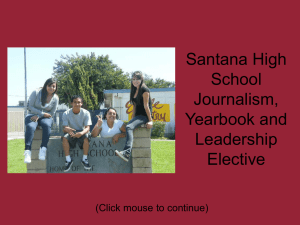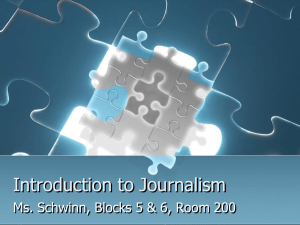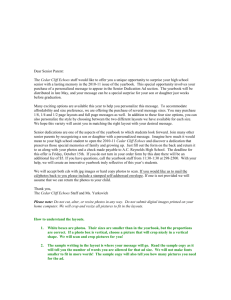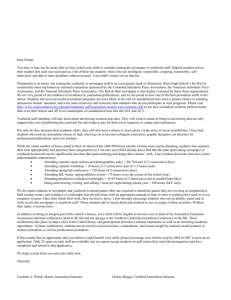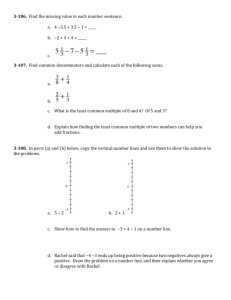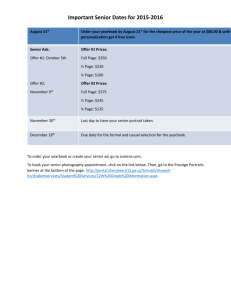School Profile - School of Journalism
advertisement
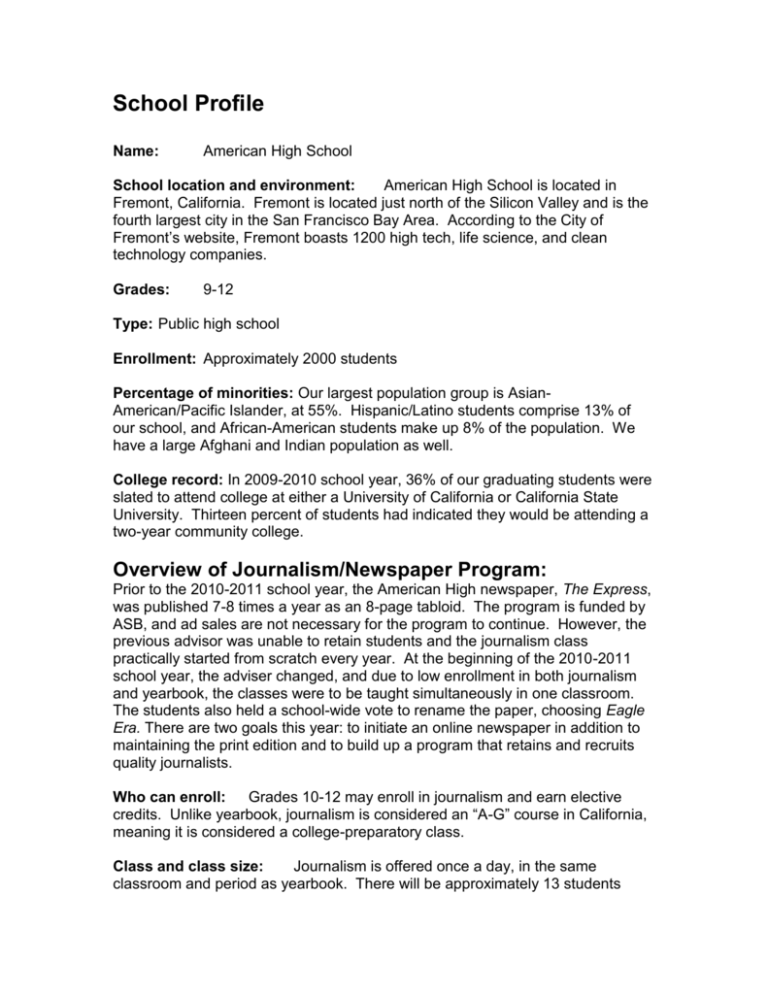
School Profile Name: American High School School location and environment: American High School is located in Fremont, California. Fremont is located just north of the Silicon Valley and is the fourth largest city in the San Francisco Bay Area. According to the City of Fremont’s website, Fremont boasts 1200 high tech, life science, and clean technology companies. Grades: 9-12 Type: Public high school Enrollment: Approximately 2000 students Percentage of minorities: Our largest population group is AsianAmerican/Pacific Islander, at 55%. Hispanic/Latino students comprise 13% of our school, and African-American students make up 8% of the population. We have a large Afghani and Indian population as well. College record: In 2009-2010 school year, 36% of our graduating students were slated to attend college at either a University of California or California State University. Thirteen percent of students had indicated they would be attending a two-year community college. Overview of Journalism/Newspaper Program: Prior to the 2010-2011 school year, the American High newspaper, The Express, was published 7-8 times a year as an 8-page tabloid. The program is funded by ASB, and ad sales are not necessary for the program to continue. However, the previous advisor was unable to retain students and the journalism class practically started from scratch every year. At the beginning of the 2010-2011 school year, the adviser changed, and due to low enrollment in both journalism and yearbook, the classes were to be taught simultaneously in one classroom. The students also held a school-wide vote to rename the paper, choosing Eagle Era. There are two goals this year: to initiate an online newspaper in addition to maintaining the print edition and to build up a program that retains and recruits quality journalists. Who can enroll: Grades 10-12 may enroll in journalism and earn elective credits. Unlike yearbook, journalism is considered an “A-G” course in California, meaning it is considered a college-preparatory class. Class and class size: Journalism is offered once a day, in the same classroom and period as yearbook. There will be approximately 13 students enrolled in journalism and 18 in yearbook. There are three returning journalism students this year. Students enrolled in journalism will work solely on the print and online versions of the paper. Yearbook students work solely on the yearbook. Production and technology: Eagle Era is published seven times a year. It is formatted using InDesign, which is installed on only one computer. Students write and edit articles on GoogleDocs and post photos on Picasa. For printing, the newspaper file is converted to a pdf and sent as a file to the printing company. Learning environment and issues: American High is a fairly competitive school. Many students choose to take honors and AP classes, leaving little time for college prep classes like Journalism. However, the class is an inclusive class, where we welcome students of all abilities, provided they are willing to work hard. Freshmen who were not enrolled in their journalism or yearbook class at the middle school level must get approval from their previous English teacher to join. All students enrolled are expected to contribute articles and photographs for each publication of Eagle Era. Focus of curriculum and lesson plans: For the first six weeks of the school year, most of the curriculum and lesson plans will be used for both the journalism students and the yearbook students. For both publications, the greatest challenge has been quality and in-depth reporting, making deadlines, and the importance of high-quality photographs and graphics in the making of visually appealing publications. Because of the challenges in having two separate publications taught simultaneously and the inexperience of both staffs, there is great room for growth. To get students on the right track from the beginning, the first six weeks will cover the following topics: First Amendment issues and ethics Interviewing skills Feature writing Photography Caption and headline writing Layout Assessment and evaluation: This is the most challenging part of being an adviser- how do I evaluate student performance? This year, students will be evaluated on the following per article: Article proposal, including topic, angle, research, and scheduled interviews Interviews- were they done in a timely fashion with people who reflect the school’s diverse population? Were the questions open-ended and not leading? 1st draft is completely written on time using the guidelines presented in class. It is available on GoogleDocs to the editor, adviser, and one other person. 2nd draft shows the writer took into consideration the remarks left by editor, adviser, and peers. It is done on time. Final draft is done on time with all needed corrections. It is ready to be placed in the layout. Photos are taken at the time of the event and/or interview. There should be at least five uploaded to Picasa and available to the editor and adviser. Captions are written for each photo. Class format: Students are responsible for managing their own time. In class, they must be productive, either by working on an article in class (doing research, writing a draft, editing, etc.) or working on assignments for other classes because of the after-school commitment they have for the paper. At the end of each day, they will write what they accomplished in the class period and what the next step will be. These are collected at the end of the week and will be graded as participation. Lesson Plan #1 Choosing Quotes and Forming an Article Since students have a difficult time weeding out information and quotes so that they can say the most in the least amount of space, this lesson will focus on selectively choosing what information is most important and then creating an article around this information. Objectives: Students will Work in small groups Conduct research using reputable sources Create interview questions Conduct themselves professionally in interviews Collaboratively choose what and how to include information in an article Materials needed: “Choosing Quotes and Writing an Article” worksheet Envelope Pen and paper for each student Access to a computer with word processing for each group Glue/glue stick or tape Accessing Prior Knowledge: Students have already read multiple feature articles from a variety of sources. They have also been introduced the principles of feature writing, primarily through a diagram shared by Jean Action at the UT ASNE conference. They have also practiced writing questions and interviewing subjects in a respectful and professional manner. Instructional Input: 1. Students will work in groups of 3-4 with people of their choosing. 2. Students will examine a series of topics relevant to the school and its population. As a group, they will choose to explore one of these topics. (See worksheet) 3. Students will begin their research (see worksheet). Encourage them to use their own common knowledge of topic, as well as past issues of the newspaper and other documents relevant to the topic. 4. Students will choose three primary and one alternate interviewee. Each student is responsible for writing questions and setting up an interview with one of the interviewees. (See worksheet) 5. Students interview their specific person, taking meticulous notes on their worksheet. 6. Students meet in their group again. As a group, students should draw a star next to the quotes they find to be extremely helpful, relevant, or 7. 8. 9. 10. 11. insightful. They should also cross out any quotes that are off-topic or that will not contribute to the article. Students should then cut out each question-quote and place them on a table. As a group, students will place question-quotes in order from most important/interesting to least. On the back of each of the top ten question-quotes, the group should write one relevant fact or expansion. Students will glue the left side of each of the top ten question-quotes onto a piece of paper. They need to make sure that they can still read the facts on the back. Using these facts, question-quotes, and transitions, each group should write a 300-word article on their topic. Remind them that each article needs to have a lead and transitions between paragraphs. Students will write and edit multiple drafts. The copy they turn in should be publish-ready. Independent Practice: If students have successfully completed this assignment, they should have a solid background on the steps needed to write a feature article. Since the newspaper is a monthly publication, most of their articles will be written in the style of a feature article. All of yearbook’s copy is feature style as well. Assessment: Students will be evaluated on the following: Did they complete all of the tasks thoroughly and on time? Did students work cohesively in all aspects of group work? Is the final product ready for publishing, with some minor edits? Names: Choosing Quotes and Forming An Article Worksheet 1. Think about topics that are important here on campus. They should be timely and relevant to the entire school population (that includes faculty and staff). a. b. c. d. e. f. 2. Discuss with your teacher or editor which of these topics would be best for your group to research and write on. Research: On a separate piece of paper, brainstorm with your group. Write down what you already know about this topic, including who is involved and the history of the topic on hand. Research: Start looking at credible sources of information on this topic. Is it in previous issues of the school paper? What about the local paper? Is it something ASB or another organization has discussed (if so, hunt down the minutes from the meeting)? Look at possible interview subjects. a. b. c. d. Each person in the group is responsible for talking to one of these people. They should set up an interview time and location. Write at least ten good open-ended questions tailored to your subject and your interview source. Leave room between each for you to take notes. Go interview the person, Take good notes under each question. Don’t be afraid to ask follow-up questions, and write those down as well! 3. 4. 5. 6. 7. Lesson Plan #2 Layout and Design Many students have a difficult time realizing what good design is. This lesson is to help students recognize different design elements and how to incorporate them into their own work. Objectives: Students will: Look at various design elements in magazines, books, newspapers, etc. Practice using design software Create a layout relevant to the school population Materials needed: Various magazines, books, newspapers Internet access Digital camera and software needed to upload photos to computer InDesign (for journalism students) eDesign (the yearbook printer’s software for yearbook students) Color printer Accessing Background Knowledge Students will have already critiqued various publications, from both our school and other schools. They will also have the basic knowledge of the design software appropriate for their publication. Students have been assigned to bring in three sources of material, each with a layout that they find visually appealing. Instructional Input 1. Students will identify three layouts that they like from the materials they have brought in. With a partner, each student will share what elements they like about each layout and why it is effective. 2. Students will choose one layout and write a brief description of the elements used. They will discuss why it is effective and appealing to them. 3. Students will choose a second layout to imitate using the appropriate design software. Students need to either go take pictures that replicate those on the layout (for example, if the dominant photo is a person eating a strawberry, the student should take a picture of someone eating a similar food from a similar angle) or find similar ones online. 4. During class, students should share ideas and frustrations with each other while they try to imitate the first layout. 5. Students will use the third layout to use as inspiration in the creation of a layout relevant to the school. For example, if the sample layout is a spread covering a professional football game, a student would create a spread on a water polo game using similar design elements. 6. Students will turn in their writing, sample layouts, and original layouts in a portfolio. Independent Practice Students will use the knowledge gained regarding layout, design, and use of software in future layouts. Assessment and evaluation Students will be assessed and assigned points based on the following: Students selected appropriate sample layouts Students are able to verbalize the elements of a layout and what makes it effective. They should also be able to write this as well. Students are creative in finding or taking appropriate photos that reflect the design of the sample layout. Students are creative in topic selection for their own layout, while maintaining the basic elements found in the sample layout.
